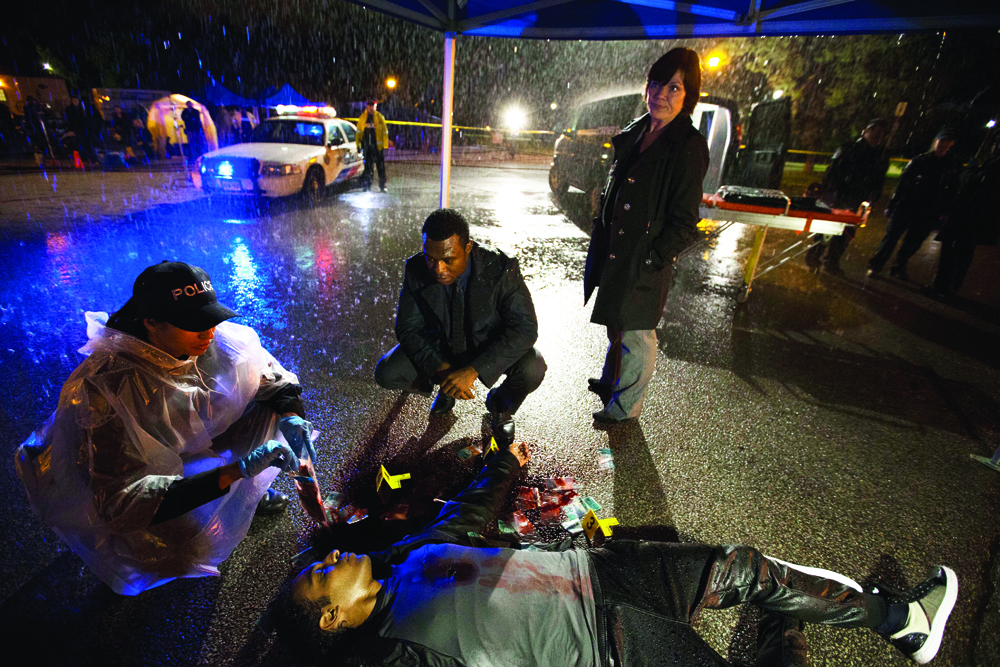Bernice Afriyie | Arts Editor
Featured image: Shoot the Messenger is a crime drama that centers around Elyse Levesque’s character Daisy Channing, as she balances her journalism career with her overlapping personal life. | Courtesy of CBC
What makes a television show successful? A more appropriate question in our Netflix-obsessed, online-streaming, cable-versus-network-television era would be what makes a show binge-worthy? It takes something special to cause thousands, or millions, of people to consider foregoing sleep, food and basic hygiene in the name of How to Get Away with Murder or Stranger Things. CBC has a slew of shows debuting this fall that may cause students to opt for the remote instead of their books.
In anticipation of the premiere of Shoot the Messenger on October 10, Excalibur sat down with co-creator and writer Jennifer Holness and co-creator and director Sudz Sutherland. The pair met while writing for Excalibur and decided to create a production company after they graduated, even though Holness didn’t have any film experience. The gamble paid off, as the duo have received many accolades for their past films, including eight Geminis between them, and are a recognized force in Canadian cinema.
Shoot the Messenger is a crime drama that centers around Elyse Levesque’s character Daisy Channing, as she balances her journalism career with her overlapping personal life. The show delves into the lives of politicians, police officers, journalists and gang members, exposing a messy web of lies and secrets.
“For us, the intersection of journalism and cops, and crime and urban drama are things that we really watch a lot […] and we wanted to do our version of it,” says Holness.
Set in Toronto, with references to Harbourfront and other Toronto districts, Holness and Sutherland situate an iconically American crime genre, which includes The Wire, True Detective and The Killing, to name a few, in the turmoil that ensues from the shooting of a young Somali artist.
Not only does the shift in setting provide a nuanced take on crime dramas, it creates a space in television for Somali, Eritrean and Ethiopian actors. “These actors have been around but they were never really given that opportunity in film and television to develop real characters with real arcs,” explains Sutherland.
Holness and Sutherland spoke to members of these communities to ensure that they were represented in an authentic and respectful manner. The focus on East African actors and their experiences, values and communities adds some variation to the colour palette of black representation in television. Viola Davis, Idris Elba, Kerry Washington and Don Cheadle are examples of black actresses and actors who have made great strides in leading roles, but they represent one face of blackness.
This isn’t to take away from these accomplishments or privilege one kind of blackness over another. Having people of colour in the media is essential, but in our praise, we need to be constantly critical of how blackness is constructed and portrayed. Even though Shoot the Messenger is framed by a predominantly white cast, it still offers a look into a blackness that does not get much television buzz.
In the same way that Holness and Sutherland are mindful of the representation of race in the development of Shoot the Messenger, they are very aware of how the show deals with images of black men, gangs and violence.
“We know that we’ve profited from them because these are the images that are catch-hold and controversial. People want to talk about it and fund our project,” admits Sutherland.
“We’re always questioning that nature. We are showing an image of a black man with a gun and we’re part of an overall narrative that looks at black men with fear […] That’s always a conscious choice of the image making we’re doing.” The show admits its complicitness in participating in the sensationalization of black lives with Daisy photographing the dead body of Khaalid Suleman in the opening scenes of episode one.
The plot develops, and subsequent inaccurate reporting of the story can be viewed as a commentary on how the media frames or leaves out crucial details in the killing of black men and women in the United States. Shoot the Messenger doesn’t allow viewers to make dismissive conclusions about good and bad or white and black. It’s refreshing to see a show that is interested in pushing the stylistic envelope with unique frames and scene transitions and also presents new ways of engaging with characters.
Romance is unavoidable when it comes to primetime dramas and Shoot the Messenger does not fail to deliver. Daisy walks between the police world and her journalism career and in doing so, has to negotiate her relationship with detective Kevin Lutz, played by Lyriq Bent. The love triangle trope is put to use with Daisy’s interest in coworker Simon Olenski, played by Lucas Bryant. The love triangle is amusing at times, but the real beating heart of the show is its melting pot approach to drama.
No one is exempt from scrutiny, from the mayor’s office down to community members; shit slips sideways, not downhill. Daisy and her informant Hassan Ali, played by Araya Mengesha, deconstruct racial, political and criminal hierarchies to show that the people policing Toronto and the people living in the communities affect one another in powerful ways.
Good television should not allow viewers to unplug or unwind from their world while they are subliminally fed propaganda and images about how to be in the world. Good television—all television—should strive to connect with the world around us so there’s no way that anyone cannot feel wound up about injustices. In this age of mass media consumption, Netflix and breakout television hits, we are like uninformed vegetables plugged into our screens. But don’t shoot me, I’m just the messenger.


